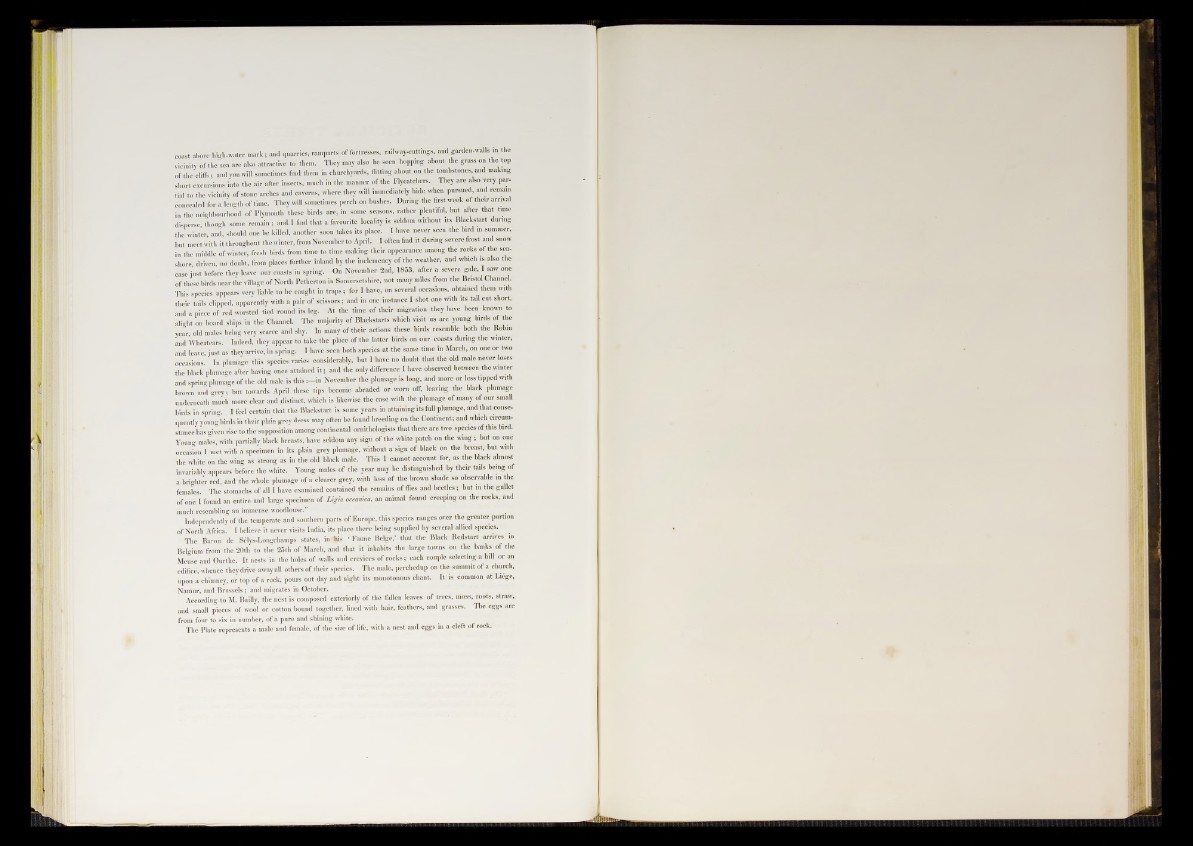
coast above high-water mark I and quarries, ramparts of fortresses, railway-cuttings, and garden-walls in the
vicinity of the sea are also attractive to them. They may also be seen hopping ahout the grass on the top
of the cliffs: and yon will sometimes find them in churchyards, flitting about on the tombstones, and making
short excursions into the air after insects, much in the manner of the Flycatchers. They are also very partial
to the vicinity of stone arches and caverns, where they will immediately hide when pursued, and remain
concealed for a length of time. They will sometimes perch on hushes. During the first week of their arrival
in the neighbourhood of Plymouth these birds are, in some seasons, rather plentiful, but after that time
disperse, though some remain I and. I find that a favourite locality is seldom without its Blackstart during
the winter and, should one be killed, another soon takes its place. I have never seen the bird in summer,
hut meet with it throughout the winter, from November to April. I often find it during severe frost and snow
in the middle of winter, fresh birds from time to time making their appearance among the rocks of the seashore
driven, no doubt, from places further inland by the inclemency of the weather, and which is also the
case just before they leave our coasts g spring. On November 2nd, 1853, after a severe gale, I saw one
of these birds near the village o f North Petherton in Somersetshire, not many miles from the Bristol Channel.
This species appears very liable to be caught in traps ; for I have, on several occasions, obtained them with
their tails clipped, apparently with a pair of scissors; and in one instance I shot one with its tail cut short,
and a piece of red worsted tied round its leg. At the time of their migration they have been known to
alight on board ships in the Channel. The majority of Blackstarts which visit us are young birds of the
year old males being very scarce and shy. In many of their actions these birds resemble both the Robin
and Wheatears. Indeed, they appear to take the place of the latter birds on our coasts during the winter,
and leave just as they arrive, in spring. I have seen both species at the same time in March, on one or two
occasions. In plumage this species varies considerably, but I have no doubt that the old male never loses
the black plumage after having once attained i t; and the only difference I have observed between the winter
and sprinwplumage o f the old male is t h i s i n November the plumage is long, and more or less tipped with
brown and grey; but towards April these tips become abraded or worn off, leaving the black plumage
underneath much more clear and distinct, which is likewise the case with the plumage of many o f our small
birds in spring. I feel certain that the Blackstart is some years in attaining its full plumage, and that consequently
youn°- birds in their plain grey dress may often be found breeding on the Continent; and which circumstance
has gken rise to the supposition among continental ornithologists that there are two species of this bird.
Young males, with partially black breasts, have seldom any sign of the white patch on the wing ; but on one
occasion I met with a specimen in its plain grey plumage, without a sign o f black on the breast, but with
the white on the wing as strong as in the old black male. This I cannot account for, as the black almost
invarinblv appears before the white. Young males of the year may be distinguished by their tails being of
a brighter red, and the whole plumage of a clearer grey, with less of the brown shade so observable m the
females. The stomachs of all I have examined contained the remains o f flies and beetles; but m the gullet
of one I found an entire and large specimen of Ligia oceanic, an animal found creeping on the rocks, and
much resembling an immense woodlouse.”
Independently of the temperate and southern parts of Europe, this species ranges over the greater portion
of North Africa. I believe it never visits India, its place there being supplied by several allied species.
The Baron de Selys-Longchamps states, in 'h is ‘ Faune Beige,’ that the Black Redstart arrives in
Belgium from the 20th to the 25th of March, and that it inhabits the large towns on the banks of the
Meuse and Ourthe. I t nests in the holes of walls and crevices of rocks; each couple selecting a hill or an
edifice, whence they drive away all others of their species. The male, perchcdup on the summit o f a church,
upon a chimney, or top of a rock, pours out day and night its monotonous chant. It is common at Liege,
Namur, and Brussels; and migrates in October.
According to M. Bailly, tbe nest is composed exteriorly of the fallen leaves of trees, moss, roots, straw,
and small pieces of wool or cotton bound together, lined with hair, feathers, and grasses. The eggs are
from four to six in number, of a pure and shining white.
The Plate represents a male and female, of the size of life, with a nest and eggs in a cleft of rock.